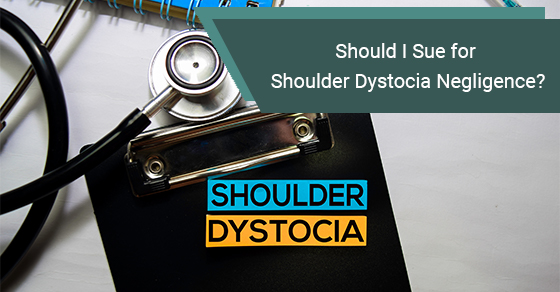While a child’s birth can be a time of great joy, it can also, unfortunately, lead to complications that have a lifelong impact on a child’s health. Shoulder dystocia is a birth complication that occurs when one or both of a baby’s shoulders become lodged in the birth canal.
If your child was a victim of shoulder dystocia negligence, you might consider suing the medical professionals who assisted with your child’s birth. Before you do so, however, you need to know the following:
- What risk factors are associated with shoulder dystocia?
- What impact shoulder dystocia negligence can have on your child?
- What’s involved in pursuing a shoulder dystocia negligence lawsuit?
At Sommers Roth and Elmaleh, we have more than 40 years of experience helping families who have been victims of medical errors. Our medical malpractice lawyers can help you pursue a shoulder dystocia negligence lawsuit.
What are the risk factors associated with shoulder dystocia?
These are some of the most common risk factors associated with shoulder dystocia:
- The mother is obese or diabetic.
- The baby is quite large or arrives after its due date.
- The mother is pregnant with more than one child.
- The mother has a diminutive stature.
- The mother had issues with shoulder dystocia during past deliveries.
Shoulder dystocia can also occur when none of these risk factors are present. While it is impossible to prevent shoulder dystocia from occurring altogether, there are actions that medical professionals can take to appropriately handle it, such as repositioning the mother during delivery or performing a C-section.
If you had risk factors for shoulder dystocia, and your medical team failed to prepare for it appropriately, you may have grounds for a shoulder dystocia negligence lawsuit.
What impact can shoulder dystocia negligence have on your child?
If shoulder dystocia is handled appropriately, it may not impact your child. If, however, the medical team attending to mother and child during birth does not act quickly or appropriately, your child can be seriously injured. They may have:
- Bone fractures in their shoulders.
- Brain damage due to not getting enough oxygen.
- Nerve damage, which can lead to Erb’s palsy or Klumpke’s palsy.
- Brachial plexus injuries. These types of injuries can cause various issues, including muscular weakness and loss of feeling in the affected limbs.
In addition, shoulder dystocia during birth can injure the mother and cause issues such as a torn cervix or postpartum hemorrhaging.
Families who have been victims of shoulder dystocia negligence are entitled to file a medical malpractice lawsuit.
What is involved in pursuing a shoulder dystocia negligence lawsuit?
To successfully pursue a shoulder dystocia negligence lawsuit, a plaintiff or their lawyers must be able to prove that the healthcare team attending to the mother and child during birth did not provide an expected standard of care.
These are some examples of potential shoulder dystocia negligence:
- The doctor delivering the baby did not recognize the warning signs of shoulder dystocia, nor did they prepare appropriately to handle it.
- The doctor did not warn a high-risk mother about the risk of injuries from shoulder dystocia nor propose a C-section to avoid the risk.
- The doctor acted inappropriately when shoulder dystocia occurred (for example, pulling on the baby’s arms), thus injuring the baby, the mother, or both of them.
It can be challenging for a plaintiff to prove that an expected level of care was not provided, leading to shoulder dystocia negligence. However, a medical malpractice lawyer can help you effectively pursue your case.
How can Sommers Roth and Elmaleh help me if I want to pursue a shoulder dystocia negligence lawsuit?
At Sommers Roth and Elmaleh, our medical malpractice lawyers have extensive experience with birth injury lawsuits, including shoulder dystocia negligence lawsuits.
When you meet with one of our medical malpractice lawyers to discuss a shoulder dystocia negligence lawsuit, they will:
- Explain to you the most common risk factors associated with shoulder dystocia.
- Break down what is and is not considered appropriate treatment when shoulder dystocia occurs.
- Talk to you about what needs to be proved to win a shoulder dystocia negligence lawsuit. One of the keys to winning such a lawsuit is having expert testimony to explain how the medical team failed to provide an acceptable level of care.
- Specify what kind of damages you may be eligible for. Compensation from a shoulder dystocia negligence lawsuit can be used in a variety of ways, including paying for physical therapy, home accessibility modifications, and attendant care services, such as private nurses and personal support workers.
Our goal at Sommers Roth and Elmaleh is to get our clients and their families the financial compensation they deserve.
Shoulder dystocia negligence can have a massive impact on your child’s life
We’ve explained some of the maternal risk factors associated with shoulder dystocia, the impact of shoulder dystocia on both a child and their mother, and what’s involved with pursuing a shoulder dystocia negligence lawsuit.
At Sommers Roth and Elmaleh, we have extensive experience pursuing medical malpractice lawsuits associated with birth injuries, including shoulder dystocia negligence lawsuits. Our medical malpractice lawyers will explain everything you need to know about suing for shoulder dystocia negligence, including what kind of compensation you may be eligible for.
Contact Us to Learn More
Your focus should be on supporting your family, and working with a malpractice lawyer to fight a shoulder dystocia negligence lawsuit can help you do just that. Call Sommers Roth and Elmaleh at 1-844-777-7372 or contact us online to learn more about how we can help you.

